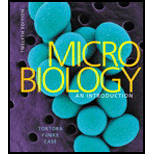
To write:
Many serological tests use the antibodies against the particular pathogen but the Salmonella typhi has three antigens, such as the IgM antibodies production is deficient in nature, and production is made by hybridoma technology.
Given:
Production of antibodies by the Salmonella typhi for the serological test to confirm the presence of antigen in humans.
Introduction:
Salmonella typhi is a gram negative bacteria which is the causative agent for typhoid fever. When it is infected to a person, his immune system produces IgG, IgM and IgA antibodies, since it has three antigens but there is a high specificity in IgM antibody compared to IgG antibody. Widal test often gives false-positive results with other gram negative bacteria.
Want to see the full answer?
Check out a sample textbook solution
Chapter 18 Solutions
Microbiology: An Introduction
- Why is storing the spleens on Dulbecco’s phosphate-buffered saline solution containing 3% fetal bovine serum and 1% antibiotic-antimycotic on ice done in splenocyte preparation?arrow_forwardWhat other infections or conditions can be detected by an ELISA?arrow_forwardWhat is the effect of not adding the primary antibody to the ELISA reaction?arrow_forward
- Why do we interpret positive hemolysis in the complement fixationtest to mean negative for the test substance?arrow_forwardHow is a direct agglutination test different from a passive agglutination test?arrow_forwardIf you were using the ELISA to look for the presence of antibodies and the sample gave a negative result, does this mean that there were no antibodies present? Explain.arrow_forward
- What component must have been present in the positive control solution (antigen, anti-HIV IgG antibodies, or secondary antibody)? Explain how you know this is true.arrow_forwardDescribe the term serology and explain the immunologic principle behind serological tests.arrow_forwardWhat two S. aureus antigens are being detected with the use of this test kit?arrow_forward
- how does immunoelectrophoresis detect immunoglobulin productionarrow_forwardWhy do some tests for antibody in serum (such as for HIV and syphilis)require backup verification with additional tests at a later date?arrow_forwardIs rapid antibody testing a form of ELISA? Explain your answer. How is an ELISA different from rapid antibody testing? Describe how antibodies are used to detect the presence of a specific disease.arrow_forward
